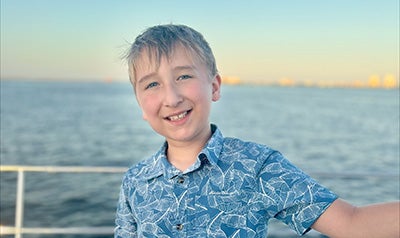CNS embryonal tumor
In January of 2021, Jaxan Jernigan was a vibrant 6 year old with a love for marina life and being out on the water. That’s when he started experiencing headaches. His parents, Craig and Lindsey, thought that perhaps he was simply dehydrated. After all, he was an active child. But just days later, the problem progressed: he suddenly became unresponsive and had to be rushed to the hospital. “He was just sitting on the bed playing with his iPad when all of a sudden he was out of it,” Lindsey explained. “He wasn’t responding to me, and at first, I thought he was just playing around. But it quickly was evident that something was really wrong.”
Jaxan was having seizures, the family soon discovered, and he was rushed to the local hospital in Pensacola, Florida. But nothing prepared them for the moments that came next. After a series of tests, the family received the news that Jaxan had a large brain tumor. “In the moment they told us, it was hard to believe it was even possible,” Craig said. “We literally just went from having a healthy child to one that was prepping for major brain surgery.”
The hope was that the tumor was benign, but it wouldn’t be known until it was removed. Two weeks later, the family was waiting for what was to be a six to seven hour surgery to be completed. It ended up taking 14 hours. “We were obviously beside ourselves the whole time, but once it was over, the doctor let us know that everything went well,” Craig said. But they also received the news that Jaxan’s tumor was a central nervous system (CNS) embryonal tumor, which is a high-grade, aggressive tumor. “I don’t think we were in a state of mind to process what that meant; we were just relieved he survived the surgery,” Craig added.
That relief soon turned into a drive to fight the disease with all they had and find the best possible care. That led them to Children’s of Alabama. They learned about a clinical trial that was taking place there, led by Dr. Girish Dhall, director of the Division of Hematology, Oncology and the Blood and Marrow Transplantation program. With the help of some friends, the family was able to get him in just one day before the deadline. “When we made it to Children’s, it immediately felt like they were there for him and for us and that we would all get through it together,” Craig said. “That was the first time we felt like there were people helping us and maybe things were going to be OK. But we still had no idea what mountain we were about to climb. All we knew was that we felt so much better after meeting Dr. Dhall.”
Jaxan started the Head Start 4 clinical trial, which included seven rounds of high-dose chemotherapy over the course of seven months, as well as three stem cell transplants. After that was over, he then had 30 rounds of brain and spinal radiation every day for 30 days. “No one likes being stuck in a hospital for so long, but they did all they could to make the terrible nightmare better,” Lindsey said. “The child life specialist would come by every day, and he’d have music and art therapies when he felt like it. They even set up an inflatable Nerf gun target game in the hallway and played with him. It really meant a lot.”
Nearly eight months later, with the final radiation complete, Jaxan was considered to be in remission. Though he continues to visit Children’s every few months for scans to ensure remission continues, Jaxan continues to thrive. Today, he’s back to an active life filled with creativity and joy and plenty of time out on the water. "He’s living life to the fullest and is a very carefree and happy child," Lindsey shared. “We owe so much of that to Dr. Dhall and the entire staff at Children’s. It was obvious that everyone at Children’s genuinely cares, and that’s truly inspiring.”











